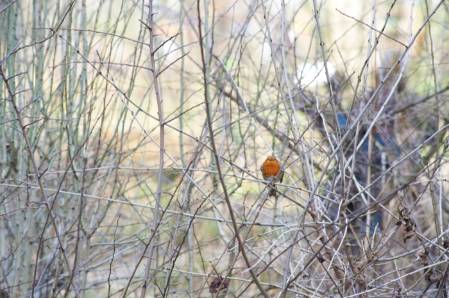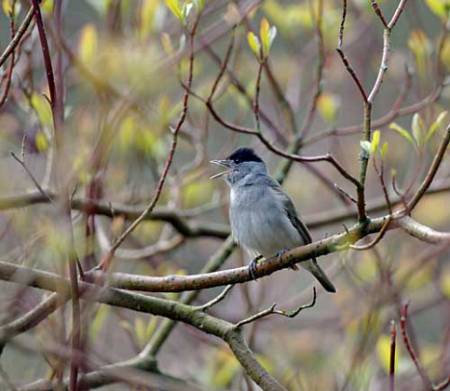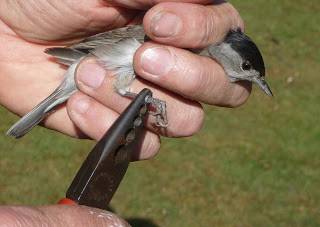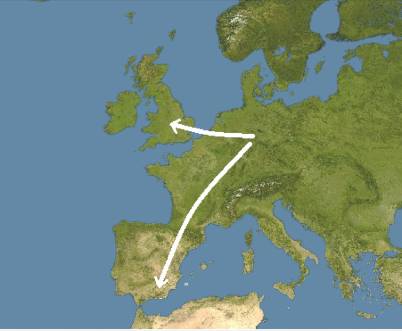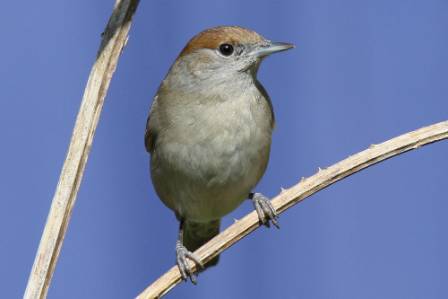Trills and twitters of finches greet us each morning - at extra volume on the chilly bright mornings - and continue throughout the day as goldfinches, greenfinches and chaffinches compete for space on our bird feeders. Flocks of blue, great and long-tailed tits forage in the tree tops and hedgerows, and occasionally join the finches for seeds or fat balls while our resident blackbirds, robins, wrens and dunnocks can be heard amongst the shrubs and leaf litter.
A robin singing through a tangle of hawthorn
© Jonathan Jackson
Over-wintering redwings were spotted swooping down to feed on the remaining holly berries last month. But what about some of our less common winter visitors? Daniel Osborne, has been looking at recent work by the British Trust for Ornithology (BTO)'s outstanding citizen science experiment Garden BirdWatch which unravels a mystery surrounding the blackcap:
"The Blackcap (Sylvia atricapilla), like other UK warblers, is primarily a summer visitor, arriving in April and May to establish a breeding territory, build a nest and raise young, then departing in September and October to overwinter in Southern Europe and North Africa. Its beautiful varied song can be heard occasionally in the Wildlife Garden in spring and summer and the bird itself - a fairly drab yet distinctive grey and light brown bird, the male with a black cap, the female a brown cap - is regularly observed among the trees and woodland and even bred in the garden in 2012.
Blackcap (Sylvia atricapilla)
© David Tipling
Since the 1950s, with the increase in use of garden bird feeders, the number of Blackcaps overwintering in the UK has increased dramatically. And in the last 30 years ornithologists have noticed the number of blackcaps in the UK during winter has seemed disproportionately large.
A number of bird ringing programmes in the UK and Europe provided the explanation. Bird ringing is the process of catching a bird, often in a net or while it is still in the nest, and attaching a small ring of metal to one of its legs before releasing it.
Bird-ringing in progress
© BTO
The hope is that the ring will be seen again, either by a keen-eyed birdwatcher or by anyone who should happen to chance upon the bird at close enough range. The ring's unique code means that scientists can be certain of an individual bird's movements. This technique has provided a number of extraordinary insights into bird migration including the large number of overwintering blackcaps.
It was found that while some German blackcaps were migrating south to Southern Europe and North Africa some were migrating to spend winter in the UK. The UK's maritime climate warmed by the Gulf Stream means that winters are milder here than in the continental climate of Germany, and global temperatures are increasing as a result of man-made climate change.
This increase in warmth is likely to mean more food, in the form of insects and berries, available during the winter and fewer sub-zero nights to endure, and has no doubt made the UK in recent years a more attractive winter destination, but surely not as attractive as Southern Europe and North Africa. That is, until the added benefit of the artificial food left out in UK gardens is taken into account.
Blackcap migration routes from Germany
The abundance and reliability of artificial food in our gardens is of course invaluable to our native species, particularly in winter. In the last 30 years or so it has also brought about this change in blackcap migration strategy. Ongoing work by Kate Plummer of the BTO has demonstrated that bird feeding activities have been important in the establishment of the overwintering blackcaps.
The food we put out for birds in winter is tempting indeed and the blackcap population that comes here, instead of heading south, enjoys some distinct advantages. The distance is about a third shorter, which means not only do the UK-wintering birds reduce the costs and perils of migration, but they actually arrive back in Germany first.
This means they can take the prime breeding territories and potentially raise a greater number of healthier young. A fascinating by-product of this is that Germany's UK-wintering population and the southerly-wintering population breed at different times and are now genetically distinct. This winter I have so far seen one female blackcap in the Wildlife Garden, but look forward to seeing more of these beautiful birds, and speculating about how they came to be spending winter in the UK."
A female blackcap
Thank you Daniel. Last weekend we cleaned and repaired our nest boxes ready for this year's residents.



